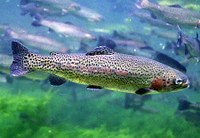Thesis defence by Khuyen TRINH DINH
- https://ilee.unamur.be/events/thesis-defence-by-khuyen-trinh-dinh
- Thesis defence by Khuyen TRINH DINH
- 2018-10-11T15:00:00+02:00
- 2018-10-11T17:00:00+02:00
- Comparative immunomodulatory responses and disease resistance of rainbow trout juveniles fed selected nutritional compounds
- When Oct 11, 2018 from 03:00 PM to 05:00 PM (Europe/Brussels / UTC200)
- Where Amphithéâtre L12, Rue Grafé, 5000 Namur
-
Add event to calendar
 iCal
iCal
 Rainbow trout is a salmonid species of major aquaculture importance. For the past decades, traditional strategy for fish disease controls in pond culture relied on the use of antibiotics and chemical disinfectants leading to the development of antibiotic-resistant bacterial strains and other problems such as environmental hazards, food safety problems and resistance of pathogens. This study aimed to evaluate the efficiency and investigate the mechanisms of action of different immunostimulating compounds (bovine lactoferrin, inulin, β-glucans, each at two dietary levels) in rainbow trout juveniles as alternatives to reduce the use of antibiotics and control fish diseases.
Rainbow trout is a salmonid species of major aquaculture importance. For the past decades, traditional strategy for fish disease controls in pond culture relied on the use of antibiotics and chemical disinfectants leading to the development of antibiotic-resistant bacterial strains and other problems such as environmental hazards, food safety problems and resistance of pathogens. This study aimed to evaluate the efficiency and investigate the mechanisms of action of different immunostimulating compounds (bovine lactoferrin, inulin, β-glucans, each at two dietary levels) in rainbow trout juveniles as alternatives to reduce the use of antibiotics and control fish diseases.
Bovine lactoferrin at low and high doses (BLf 0.1%, BLf 1%), inulin at low dose (In 0.1%) and low dose of GAS1- β-glucan (GAS1 0.2%) significantly modulated the blood leukocyte cell populations, humoral immune parameters after a short time treatment (35 days for bovine lactoferrin and inulin treatments; 15 days for β-glucans treatment), increased the expression of several immune related genes in spleen and kidney especially after long time of treatment (51 days for bovine lactoferrin and inulin tests; 36 days for β-glucans tests). Further, those compounds improved the fish disease resistance and enhanced the survival rate of rainbow trout juveniles after 14 days of infection with Aeromonas salmonicida. Meanwhile, high inulin dose (In 1%), macrogard β-glucan, wild type β-glucan, high dose of GAS 1-β-glucan and the combination diet of the best bovine lactoferrin dose (BLf 1%) + inulin (In 0.1%) + GAS1-β-glucan (GAS1 0.2%) did not improve the specific growth rate of rainbow trout juveniles compared with the control and single compounds used separately. Whereas a significant decrease of several immune gene expression levels of il-1β, tgf-1β, il-10, cd4-2β, mIgM and hepcidin was recorded in macrogard β-glucan, wild type β-glucan and high dose of GAS 1-β-glucan treatments in this study. However, BLf 1%, In 0.1%, GAS 1 0.2% and the combination of those compounds diets significantly increased the survival of rainbow trout juveniles after 14 days of bacterial challenge with A. salmonicida. Globally, low dose of inulin, low and high doses of bovine lactoferrin, and low dose of GAS1-β-glucan performed very well as immunostimulants provided orally, through the diet, in rainbow trout juveniles. Validations in field trials are still needed before promoting the use of those immunostimulants in intensive rainbow trout culture practices.
Based on the scientific literature and our own results, we can suggest some putative mechanisms of action of these compounds on the trout immune response: bovine lactoferrin compound may directly affect the fish immune system by facilitating iron absorption and transportation abilities from blood stream to the whole fish immune cells. Meanwhile, enterocytes may facilitate the transportation of β-glucans compounds across the intestinal cell wall into the lymph to interact with macrophages in order to activate immune function. Furthermore, inulin and β-glucans are fermented by bifidobacterium and acid lactic producing bacteria to produce amount of butyric - a short chain fatty acid which is reported to improve the fish immune system.
 Khuyen will present the results of his PhD thesis he conducted in the Research Unit of Environmental and Evolutionary Biology (URBE) under the supervision of Patrick Kestemont.
Khuyen will present the results of his PhD thesis he conducted in the Research Unit of Environmental and Evolutionary Biology (URBE) under the supervision of Patrick Kestemont.
 Institute of Life, Earth and Environment
Institute of Life, Earth and Environment
